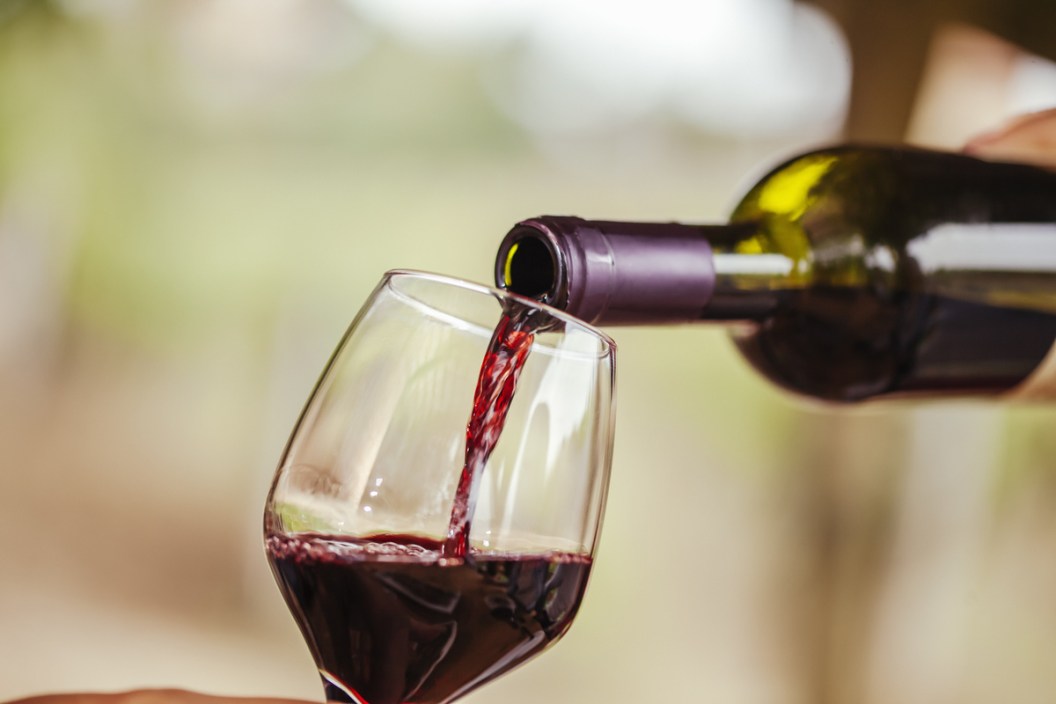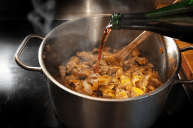It sounds like an ancient riddle: Which red wines are dry? No, not that kind of dry. Dry, in wine terms, refers to the amount of residual sugar that is left in the final fermented bottle of vino. The grape's sugar is what turns to alcohol during the fermentation process. So generally speaking, the sweeter the wine, the lower the alcohol. When you have a dry red wine, you have a higher alcohol content. Whether you're grabbing a dessert wine, a sparkling wine, or a cabernet franc, checking our your alcohol content and sweetness is part of the deal.
Tannin is a big player in this discussion. Tannins are biomolecules that are naturally found in unripe fruit, red wine, and tea. Tannin attaches itself to the proteins in our saliva, giving us that puckery, dried out, cat tongue kind of feeling. Yes, there are tannins in white wine like Sauvignon Blanc and Chardonnay. But since white wine has minimal contact with the grape skins during the winemaking process, you don't notice the tannins as much.
Wine Glass Rack
Many of the best dry red wines spend some time in oak barrels. Oak barrel aging can also impart their own tannins into the grape juice. Good winemakers are magicians and rock stars. They have lots of decisions to make all throughout the winemaking process. They may have intended to make a dry red wine but end up with a semi-sweet red blend instead. Sometimes it's the best accident of their careers! There's a life lesson in there, but I digress.
So it's a combination of the presence of tannin and the residual sugar left in a wine that will make us refer to it as dry. BUT, and that's a big but, a dry red wine can still be fruity or fruit forward as wine pros call it. The red fruit and black fruit flavors like black currant and cherry flavors can come through in that first sip before the dryness hits your tongue.
Food pairings also play into the tannins in dry red wines. When you give tannins something else to cling onto like protein rich red meats like hamburger or steak, it all balances out in your mouth. And you thought you were just enjoying a glass of wine! There's science happening, people.
So find yourself a helpful wine store and start your search for your favorite dry red wine. Here are some grape varietals that will give you a good starting point. Wine regions and appellations you might want to virtually visit include Burgundy, Rhône, Bordeaux, Italian wines, and of course, California.
Merlot
Merlot is not a one trick grape. Merlot can be dark and herby with flavors of blackberries, black cherries, and plums. Depending on the winemaker, it can taste like vanilla or chocolate, and even be turned into a sweet red wine with the addition of sugars. The tannins are generally softer, making Merlot a popular grape varietal among wine drinkers.
Cabernet Sauvignon
There are so many styles of Cabernet Sauvignon. It's always a safe choice for a dry red wine but flavors can vary widely. There can be earthy cabs that smell like leather and dirt. There can be herby cabs that smell like mint and cedar boxes. There can be cabs that are overwhelmingly chocolatey or with a cherry fruitiness that can change your life. Underneath all of it is still a dry red wine asking to be loved.
Syrah
Syrah is one of the darkest skinned grapes and is often used to add some punch to pinot noir and red blends. But pour a 100% Syrah grape wine and take notice of the unique flavors. There can be violets, smoke, mocha, and vanilla. The tannins and acidity do better with a plate of cheese at your side. Who doesn't like to have a plate of cheese to keep them company?
Pinot Noir
A fragile thin skinned varietal, pinot noir is a book unto itself, but let's keep it simple for now. You can choose a fruity California style Pinot Noir or a smokier, earthier Pinot Noir from Oregon. Go over to the French section and buy a bottle of Pinot Noir from Burgundy for the earthy, spicy, silky style. This dry red wine will always surprise you.
Malbec
If you're a Malbec drinker, most likely you buy it from the Argentina or Chile section, but Malbec originally is from Bordeaux France. You can buy a bottle of French Malbec labeled Cahors and have it taste earthier than that bottle from Argentina. They are both certainly dry red wines with dark fruit flavors and smoother tannins. Malbec is easy to drink with no food or a buffet of Taco Bell. Not that I'd know.
Nebbiolo
This grape varietal is grown in Italy's Piedmont region. Very high tannins make Nebbiolo wines, like Barolo and Barbaresco, the ultimate food wines. Depending on the food they accompany, the flavor profile really develops as you drink: licorice, rose petals and violets, spice and cinnamon. You can find a younger less expensive bottle of Nebbiolo grapes or spend a pretty penny on an aged bottle of Barolo.
Tempranillo
https://www.instagram.com/p/CL-NJ8AHZ9K/
Tempranillo is the top grape in Spain. All those Spanish wine bargains we've been guzzling for years? That's right, Tempranillo. There are flavors of cherry, figs, black currant, and tobacco smoke in the wines made from Tempranillo grapes. The famous dry red wines of Rioja are almost always made from Tempranillo plus Garnacha (aka Grenache), Syrah, and sometimes a little Cabernet.
Zinfandel
Before you ask, no, not the white zinfandel. I'm talking about the almost black, thick skinned grape that's like drinking a glass of dark fruity juice with layers of flavors. Sometimes it's peppery on the finish and sometimes it's tingly on the tongue. Zinfandel is always a flavor surprise. Zin usually has a high alcohol content and is most definitely a dry red wine but is a good example of how a dry wine can be fruit forward. California Zin is amazing and in the Italian section, look for a wine labeled Primitivo, which is the Italian name for the same grape.
Sangiovese
Sangiovese is the common denominator in Italian wines. The Sangiovese grape is what's in the wine we call Chianti. Chianti is the place and Sangiovese is the grape. Sangiovese is a dry red wine that goes hand in hand with tomato sauce.
American, or New World, winemakers are growing more and more unconventional grape varieties. It's fun to taste the same dry red wines from different regions of the world. Shiraz from Australia will taste very different from a Syrah (same grape as Shiraz, just a different name) from Washington State. Stick with these varietals we've talked about and you will be in the right place to choose your next dry red wine.
Products featured on Wide Open Eats are independently selected by our editors. However, when you buy something through our links, we may earn a commission.






